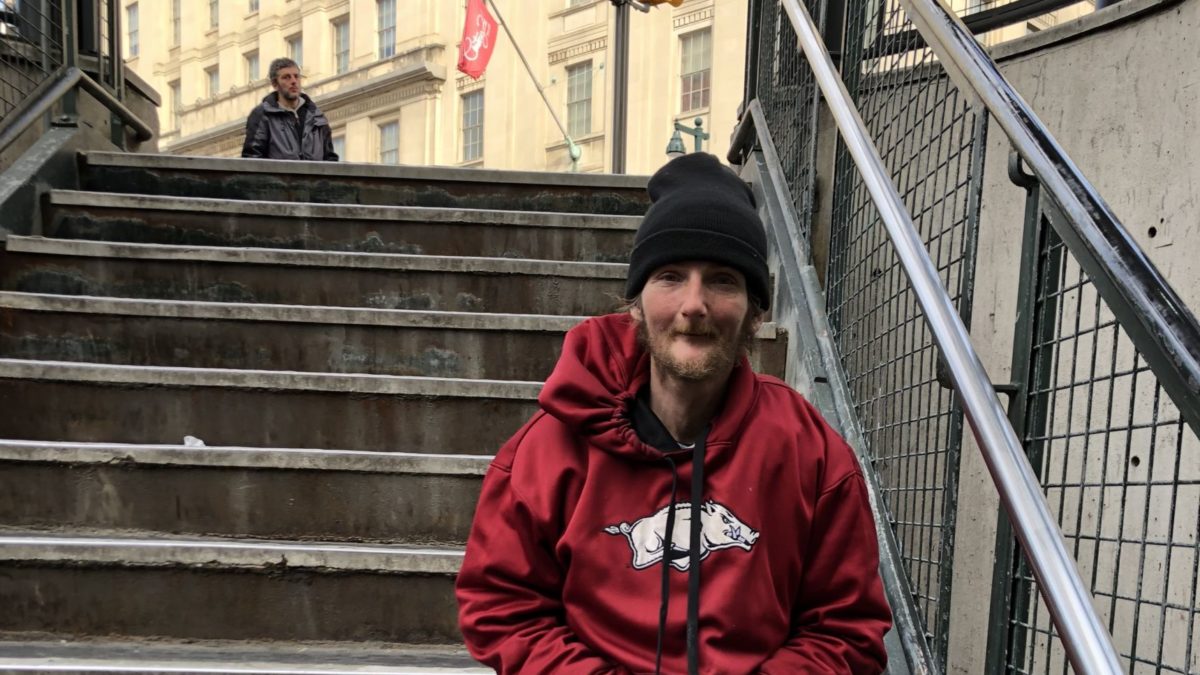Walking along Kensington Avenue while smoking a cigarette, her black hoodie pulled up against the late March chill, Lauren M., who didn’t want to give her last name, said she was mostly homeless.
“I do a lot of dates,” the 28-year-old said.
Sometimes they let her stay the night.
Sometimes Lauren stays with other friends.
Sometimes, she’s out on the street.
Until Philadelphia closed the encampment under the Emerald Street bridge, that was where she lived in a tent and called home, Lauren said.
According to a recent independent study by researchers at the University of Pennsylvania – who the City commissioned to analyze its pilot program clearing the Kensington Avenue and Tulip Street encampments last spring – about half of the encampment residents are still engaged in treatment or shelter services.
The City subsequently closed the Frankford Avenue encampment and then Emerald Street in late January, giving people living under the bridges a 30 day notice to vacate and offering outreach services on a daily basis leading up to Zero Hour. But despite the fact that the city successfully placed about half the encampment residents in treatment and/or shelter or housing, the question remains what happened to the other half?
“I don’t think anybody would seriously argue that the problem overall has been reduced,” said Stephen Metraux, part of the research team from the University of Pennsylvania’s School of Social Policy and Practice. “The problem of opioid use and homelessness in Kensington still dwarfs the size of the problem. There’s still a lot more work to be done.”
The pilot project of clearing the first two encampments led to the creation of the “Philadelphia Resilience Project,” coordinating 35 city offices to combat the opioid crisis by increasing treatment options, reducing the number of unsheltered individuals, and clearing trash and litter from neighborhoods, among other efforts. City teams are still meeting on a regular basis to go through the “by-name list,” a tracking of people experiencing homelessness, substance use, and other issues that outreach workers created each day as they walked around the encampments – and as they have moved through other parts of the city.
“What was amazing was how many people the number of people who were willing to give not only their name, but also their social security number and date of birth,” said Liz Hersh, director of the City’s Office of Homeless Services, referring to the compliance of those living in homelessness to enable outreach workers to offer or check if people had received other city services. “It enabled us to learn about them so we could tailor services to them. Clearly, people want help.”
The City felt it had to clear the encampments because of neighborhood pressure, health and safety issues, and a desire to help people find better lives. In order to do so, Hersh said City efforts took on the “Herculean task” of bringing services to the encampments on a daily basis, such as wound and other medical care, help with getting identification cards, and links to drug treatment and housing.
“This was done in a way that was humane and compassionate,” Hersh said. “People were treated respectfully and offered real alternatives in a realistic timeframe. I think we did a really good job of balancing the needs of the people experiencing homelessness and the needs of the people in the neighborhood.”
Metraux would add that the fact that the City being unable to engage more people is not a failure of the pilot project, but rather a reflection on the intractability of helping individuals who experience chronic homelessness and substance use get into housing and treatment.
__
“There are programs, I haven’t been following up. Being in the drug life, you’re afraid you’re going to miss out on something good – on that guy who drops a 10-dollar bill in your lap. The mind of a drug addict is not like that of a normal person.
– Joshua Brown, 41, experiencing homelessness in Center City
__
According to Metraux, one of the most surprising findings of the study was that 57 percent of the individuals surveyed had previously spent time in a homeless shelter and that 40 percent of encampment residents surveyed were homeless for over one year, meeting the federal definition of chronic homelessness. This population had the “double whammy” of drug use and housing needs, he said, making the city’s job particularly challenging.
Plus, now the people from the encampments are thrown into the larger population of people throughout the city who are waiting for long-term treatment and housing. “You have people who have gotten short-term services, and then the ‘what next’ steps become more difficult,” Metraux said.
Victims of circumstance
Eating a bowl of oatmeal on a recent morning in the Kensington Storefront – an arts and community hub on Kensington Avenue – Brooke Spallone reflected on her experience with homelessness and drug use. As it stands today, she lives in an “abando,” or an abandoned building, But says she is actively looking for housing.
She got on the by-name list when she was living under the Emerald Street bridge before the encampment closed, but she said “the system is way too slow.”
Efrain Lopez, 22, who was also at the Storefront and who has experienced periodic homelessness, agreed: “I gave up on giving them my name.” Spallone said a lot of people who were living under the bridges didn’t get treatment or housing and that she sees many of them “roaming around.”
Spallone will admit that for some it’s by their own doing, “Half of them chose not to go into frickin’ housing, or [the shelter offered is] way too far away from here,” she said. “People don’t want to leave, afraid of not being able to get drugs. “They’re too afraid they’re gonna get sick.”
Plus, Spallone felt you had to be “homeless in the system for a certain amount of time” to get help and that the city gave priority to those who were in the encampments. “What about the people sleeping under the El? [To me], that’s kind of messed up too,” Spallone said.
A world away from Kensington, in Center City on a recent chilly morning, Lewis Cheesman, 36, wandered near the spot where he usually panhandles outside the Starbucks at 10th and Chestnut streets. He once had a house, a family, and a job working as an elevator repairman but “broke his back” when he fell down a shaft and got hooked on painkillers.
He has been using heroin since he was 15.
Now, he sleeps on the street with “blankets, lots of blankets.” Outreach workers regularly check in with Cheesman. “They always want to put me in a shelter,” he said. “I don’t like being indoors.”
Nearby, Thomas Townsend was hanging out near the SEPTA station at 8th and Market streets. He said he’d been homeless for about four-and-a-half years, and that although outreach workers offer him shelter and other services, “My answer is yeah, I’d like to get clean, but I have a lot of medical issues.”
Townsend, who has severe back issues, Hepatitis C, and problems with his knees, said he was worried that if he went into treatment, he wouldn’t get the pain management he needed because of his history as a drug user.
Joshua Brown, 41, panhandling nearby, sitting on a crate, held up a sign that read: Homeless. I’m happy for all the blessings I am given. God bless. In total, Brown has been homeless off and on for about seven years, with “a little jail time in there,” he said.
Brown uses heroin, cocaine, and crack – a habit that started after he got hit by a car when he was 15, causing him to seek stronger painkillers on the street after he was released from the hospital. “My first memory is waking up and my mom being at my bedside in the hospital,” Brown said. He suffered a traumatic brain injury and still has memory problems, he said.
He said outreach workers frequently offer him beds in shelters but that he’s had negative experiences with theft, bed bugs, and lice. Still, Brown said he “definitely [seeks] housing” and to get on methadone but that he doesn’t have an I.D., which is a requirement for many treatment facilities.
“There are programs,” Brown said. “I haven’t been following up. Being in the drug life, you’re afraid you’re going to miss out on something good – on that guy who drops a 10-dollar bill in your lap. The mind of a drug addict is not like that of a normal person.”
Fellow panhandler George Pearce, 23, who has been using since he was 18, agreed.
“I just don’t want to go,” Pearce said. “I’m fucked in the head. I don’t think anybody should feel bad. It’s my own fault. I like getting high. It just keeps me normal. I can’t function without it. I want help, I just can’t grapple with myself to get help. My mind’s telling me to get high.”
The battle rages on
Philadelphia is up against challenging odds when it comes to getting people shelter and treatment – not just for those who had to leave the encampments but for all individuals experiencing homelessness throughout the city.
Officials hope to open a “low-barrier” facility akin to some of the programs found at Temple University Hospital’s Episcopal campus. The facility will cater to users who are not ready to give up drugs at some point.
“We’re still learning,” she said, adding that the number of those who are receiving services has increased since the Penn Study was conducted.
Lauren, walking along Kensington Avenue, said she doesn’t blame the city for kicking her out the Emerald Street encampment at the end of January. Like so many users experiencing homelessness, Lauren said she just wasn’t ready to get help.
“I guess it’s nice to know the services [are] always there for us,” she said.
TWITTER: @CHARRISBOND





